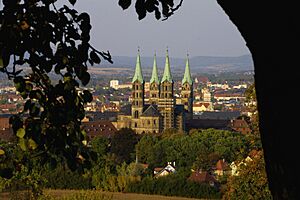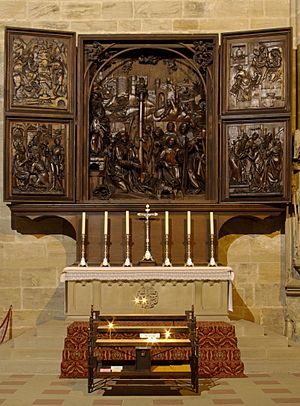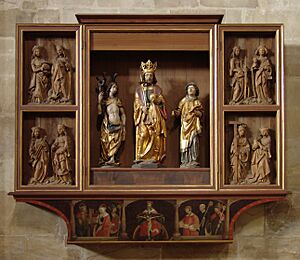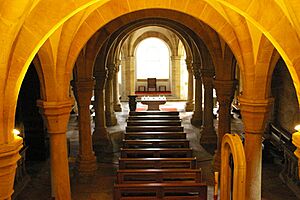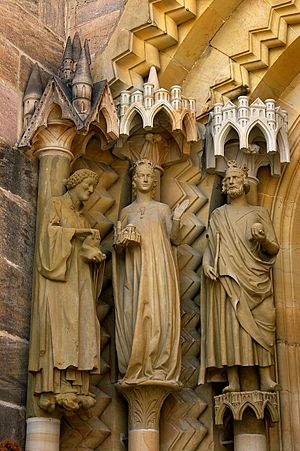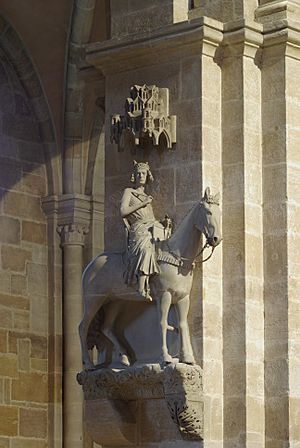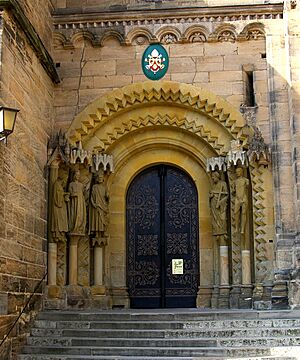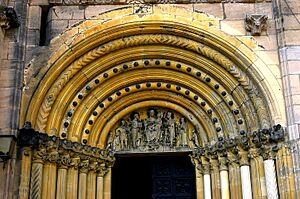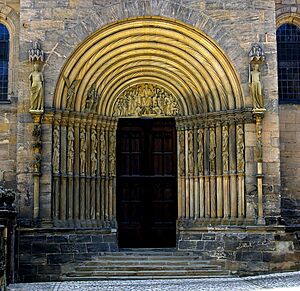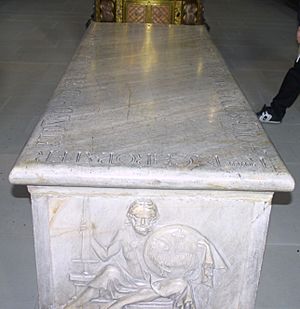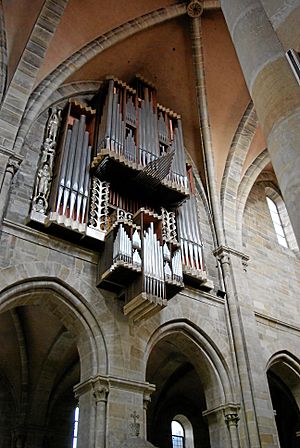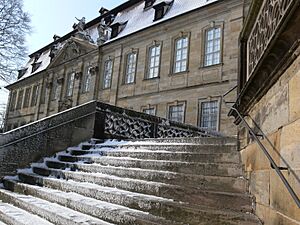Bamberg Cathedral facts for kids
Quick facts for kids Bamberg Cathedral |
|
|---|---|
| The Cathedral Church of St Peter and St George | |
|
Bamberger Dom
|
|
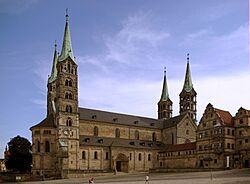
Bamberg Cathedral
|
|
| 49°53′27″N 10°52′57″E / 49.89083°N 10.88250°E | |
| Location | Bamberg |
| Country | Germany |
| Denomination | Catholic |
| Website | Website of the cathedral |
| History | |
| Status | Active |
| Founded | 1002 |
| Founder(s) | Heinrich II (Henry II) |
| Consecrated | 6 May 1012 |
| Architecture | |
| Functional status | Metropolitan Cathedral, Minor Basilica |
| Style | Romanesque |
| Completed | 1012 |
| Specifications | |
| Length | 94 metres |
| Width | 28 metres |
| Height | 26 metres |
| Number of spires | 4 |
| Spire height | 81 metres |
| Administration | |
| Archdiocese | Archdiocese of Bamberg |
Bamberg Cathedral (in German, Bamberger Dom) is a very old and important church in Bamberg, Germany. It was finished in the 13th century. This huge church is the main church for the Archdiocese of Bamberg and is where the archbishop works. Since 1993, the cathedral has been part of the UNESCO World Heritage Site called "Town of Bamberg." This means it's a special place recognized for its historical and cultural value.
The cathedral was started in 1002 by King Heinrich II (Henry II), who later became an Emperor. It was officially opened in 1012. Inside, you can find the tombs of Henry II and his wife, Cunigunde. They are the only imperial couple (Emperor and Empress) who were made saints. The cathedral also holds the only grave of a Pope in Germany, and the only one north of the Alps! Pope Clement II lived from 1005 to 1047.
The first two cathedrals on this spot burned down in the 11th and 12th centuries. The building you see today is a late Romanesque style church with four tall towers. It was built in the 13th century.
The cathedral is about 94 meters (308 feet) long, 28 meters (92 feet) wide, and 26 meters (85 feet) high. Each of its four towers stands about 81 meters (266 feet) tall. It's filled with amazing artworks. These include the marble tomb of its founders, Emperor Henry II and Empress Kunigunde. This tomb is a masterpiece by the famous sculptor Tilman Riemenschneider, who carved it between 1499 and 1513.
Another famous treasure is an equestrian statue called the Bamberg Horseman. This statue, which might show the Hungarian king Stephen I, was likely made between 1225 and 1237. It's special because it's the first statue of a horseman like it since ancient times.
Contents
History of Bamberg Cathedral
How it Started
Heinrich (Henry) became the Duke of Bavaria in 995. He loved the town of Bamberg and gave it to his wife Kunigunde as a wedding gift around the year 1000. In 1002, Heinrich was chosen as King of Germany. He started running his government from Bamberg and gave the town special rights, like making its own money.
Around 1002, he decided to create a new church area (diocese) in Bamberg. Even though other bishops didn't like losing parts of their land, the church meeting in Frankfurt in 1007 officially created the Diocese of Bamberg. Heinrich wanted a strong church presence on the eastern border of his kingdom. The first bishop was Eberhard I. In 1007, the diocese came directly under the Pope's authority, meaning it was very important.
Building the Cathedral
Building the first cathedral began in 1002. It was officially opened on May 6, 1012, which was Heinrich's birthday. This first cathedral was a cross-shaped church with two main areas for singing (choirs) and two towers. It was about 75 meters (246 feet) long. Sadly, this cathedral burned down in 1081. Most of the art inside was destroyed, but the building itself wasn't too badly damaged. It was quickly rebuilt and reopened in 1111 by Bishop Otto.
However, this rebuilt church also burned down in 1185.
In 1047, the body of Pope Clement II was brought from Rome to Bamberg and buried in the cathedral. This is very special because it's the only grave of a Pope in Germany.
The cathedral you see today is a late Romanesque building. It was built by three important men from the Andechs-Merania family: Otto VI, Ekbert of Bamberg, and Poppo. They were bishops between 1177 and 1242. Because the church leaders were wealthy and the Andechs-Merania family was generous, they built a very grand church. It was officially opened on May 6, 1237.
Changes Over Time
Emperor Heinrich was made a saint in 1146, and Kunigunde in 1200. Many beautiful artworks were added during the Gothic period.
In the 17th century, the inside of the cathedral was changed to the Baroque style. Old stained-glass windows were removed, and frescoes (wall paintings) were painted over. New altars were also added.
Later, from 1828 to 1837, King Ludwig I of Bavaria ordered changes to make the cathedral look more like its original medieval style. He saw it as an important national monument. Many Baroque artworks were sold off, and new art in the Romanesque Revival style was brought in.
From 1969 to 1974, the church was updated again to fit modern church practices. For example, the main altar was moved.
Exploring Bamberg Cathedral
Size and Style
The cathedral is about 94 meters (308 feet) long, 28 meters (92 feet) wide, and 26 meters (85 feet) high. Its four towers are each about 81 meters (266 feet) tall.
Because it took a long time to build, the cathedral shows different building styles. You can see both Romanesque and Gothic styles. The main part of the church, called the nave, shows a mix of these two styles.
The current building is mostly late Romanesque with four large towers. The eastern towers were made taller after 1766 to match the western ones. The western towers are in an early Gothic style.
The Choirs
The cathedral has a special area for singing, called a choir, at both ends. The eastern choir is the oldest part and is purely Romanesque. It's dedicated to St. George, representing the Holy Roman Empire. The western choir is early Gothic and was built around 1232. It's dedicated to St. Peter, symbolizing the Pope.
The eastern choir is raised because there's a crypt (underground room) beneath it. It has old choir stalls from the 14th century. The western choir holds the bishop's special chair (cathedra) and the grave of Pope Clement II. It also has beautiful Gothic choir stalls.
Side Areas (Transepts and Aisles)
The northern side area (transept) has a late Gothic altar from around 1500, dedicated to Mary. It used to be in another church.
The southern side area has a large Nativity altar made of wood by the artist Veit Stoss between 1520 and 1523. It was originally meant for a church in Nuremberg.
The main part of the church, the nave, connects the two choirs. Here you'll find the imperial tomb, the famous Bamberg Horseman, a pulpit, and the organ.
In the side aisles (passageways), there are two more notable altars. One is dedicated to Mary and dates from the 16th century. The other, called the Riemenschneider Altar, was put together in 1926 from different figures made around 1500.
Underground Rooms (Crypts)
The western crypt was filled in for a long time but was reopened between 1987 and 1995. It still has parts of Heinrich's original cathedral. Today, it's where the Archbishops of Bamberg are buried. In 1997, a special chapel was made under the northwestern tower to hold the skulls of the two founders, Heinrich and Kunigunde, in a glass case.
The eastern crypt was built around 1200. It holds the tombs of bishops from the 11th and 12th centuries, and the tomb of King Konrad III, who died in Bamberg in 1152. There's also a well used for baptisms.
Small Chapels
Nagelkapelle
This chapel used to be a meeting hall for the church leaders. Its name, "Nail Chapel," comes from a nail that is said to be from the True Cross (the cross Jesus was crucified on). People have honored this nail in Bamberg since the 14th century.
Sakramentskapelle
This chapel was renamed in 1974. It's now used to store the sacramental bread for the Eucharist (a Christian ceremony). It has a painting from around 1520 that is thought to be by Lucas Cranach the Elder.
Amazing Sculptures and Carvings
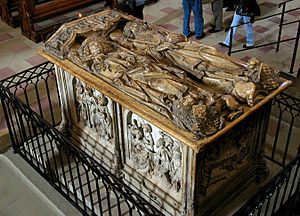
The cathedral is full of beautiful sculptures both inside and outside.
Tomb of Heinrich and Kunigunde
One of the most famous artworks is the tomb of Emperor Heinrich II and Empress Kunigunde. It was carved by the sculptor Tilman Riemenschneider from special stone and marble. It took him 14 years to finish, from 1499 to 1513. The tomb is near the eastern choir and is about 1.7 meters (5.6 feet) tall. On top, you can see carvings of the Emperor and Empress. The sides of the tomb have detailed carvings that tell stories from their lives. These include the Empress walking on hot metal to prove she was innocent, and the Emperor being healed by a saint.
Bamberger Reiter (Bamberg Horseman)
Near the tomb, on a column, stands the famous equestrian statue known as the Bamberg Horseman. No one is completely sure who this knight on horseback is supposed to be. Over the years, people have had different ideas. Some thought he was a German emperor.
Today, many believe he is probably the 11th-century Hungarian king Stephen I. This idea comes from studying the original colors used to paint the statue. The artist who carved the statue never signed his name, so his identity remains a mystery. This horseman statue is likely the oldest of its kind made in Germany after Roman times.
Grand Entrances (Portals)
The cathedral has three main entrances, called portals, with many carvings. The Adamspforte and Marienpforte (or Gnadenpforte) lead into the eastern towers. Each is guarded by a carved Romanesque lion, which are very old. The Adamspforte has statues of saints and Adam and Eve. The Marienpforte shows Mary with St. Peter, St. George, Kunigunde, and Heinrich.
The main entrance is called the Fürstenportal (princes' portal). It's on the north side, not the west, because of the cathedral's two choirs. This portal was only opened on special holy days. It has carvings of prophets and apostles, and a Last Judgment scene above the door.
Papal Grave
The tomb of Pope Clement II is made of silver-grey marble. It has carvings from the early 13th century on all four sides. These carvings show important Christian ideas and scenes, like the death of the pope.
The Organ
The first organ in the cathedral was installed in 1415. The current organ was built in 1976. It has four angel figures on its case. The organ has four keyboards and a pedalboard (for playing with feet). All the organs in the cathedral's history have been placed against the north wall because the sound is best there. About 40 concerts are held in the cathedral each year.
The Bells
The cathedral has many bells, each with its own name, year it was made, and weight. Some bells are very old, like the Kunigunde bell from around 1185 and the Heinrich bell from 1311.
| No. | Name | Year | Caster, City | Diameter | Mass | Strike tone (HT-1/16) |
Tower |
|---|---|---|---|---|---|---|---|
| 1 | Apostel | 1886 | Friedrich Hamm, Frankenthal | 1,655 mm (65.2 in) |
≈2,430 kg (5,360 lb) |
h0 +5 | South-East, lower |
| 2 | Kunigunde | ca. 1185 | unknown | 1,589 / 1,590 / 1,596 mm (62.6 / 62.6 / 62.8 in) |
≈3,450 kg (7,610 lb) |
c1 +13 | North-East, upper |
| 3 | Heinrich | 13.8.1311 | unknown | 1,799 mm (70.8 in) |
≈5,200 kg (11,500 lb) |
cis1 +9 | North-East, lower |
| 4 | Maria | 1735 | Johann Ignatius Höhn, Bamberg | 1,335 mm (52.6 in) |
≈1,500 kg (3,300 lb) |
dis1 +5 | South-East, upper |
| 5 | Georg | 1972 | Rudolf Perner, Passau | 1,090 mm (43 in) |
780 kg (1,720 lb) |
fis1 +10+ | South-East, upper |
| 6 | Peter | 1972 | Rudolf Perner, Passau | 985 mm (38.8 in) |
556 kg (1,226 lb) |
gis1 +7 | South-East, upper |
| 7 | Otto | 1972 | Rudolf Perner, Passau | 822 mm (32.4 in) |
310 kg (680 lb) |
h1 +11− | South-East, upper |
| 8 | Michael | 1972 | Rudolf Perner, Passau | 653 mm (25.7 in) |
170 kg (370 lb) |
dis2 +9,5 | South-East, upper |
| 9 | Armeseelen | ca. 1200 | unknown | 837 / 844 mm (33.0 / 33.2 in) |
570 kg (1,260 lb) |
fis2 −1 | South-East, upper |
| 10 | Messe | ca. 1300 | unknown | 591 mm (23.3 in) |
≈200 kg (440 lb) |
gis2 −7 | South-East, upper |
| Name | Year of Cast | Caster | Diameter | Mass | Strike tone (HT-1/16) |
|---|---|---|---|---|---|
| Zapfendorfer oder Laudes | ca. 1200 | unknown (vgl. Armeseelenglocke) | 745 mm (29.3 in) |
≈400 kg (880 lb) |
gis2 −5 |
Other Buildings Around
The cloisters (covered walkways) and the nearby chapter house (a building for church meetings) now hold the Diözesanmuseum Bamberg (cathedral museum).
The Domkranz is a terrace that you can reach by two wide stairways from the main square. From here, you can enter the cathedral through the Adamspforte and Gnadenpforte portals.
The Cathedral Square (Domplatz)
The square in front of the cathedral is called Domplatz. It's surrounded by other important historical buildings. These include the Renaissance-style Alte Hofhaltung and the Baroque Neue Residenz. These were the palaces where the bishops lived at different times in history.
The square was once known by other names, but in 1949, Domplatz became its official name.
See also
 In Spanish: Catedral de Bamberg para niños
In Spanish: Catedral de Bamberg para niños



